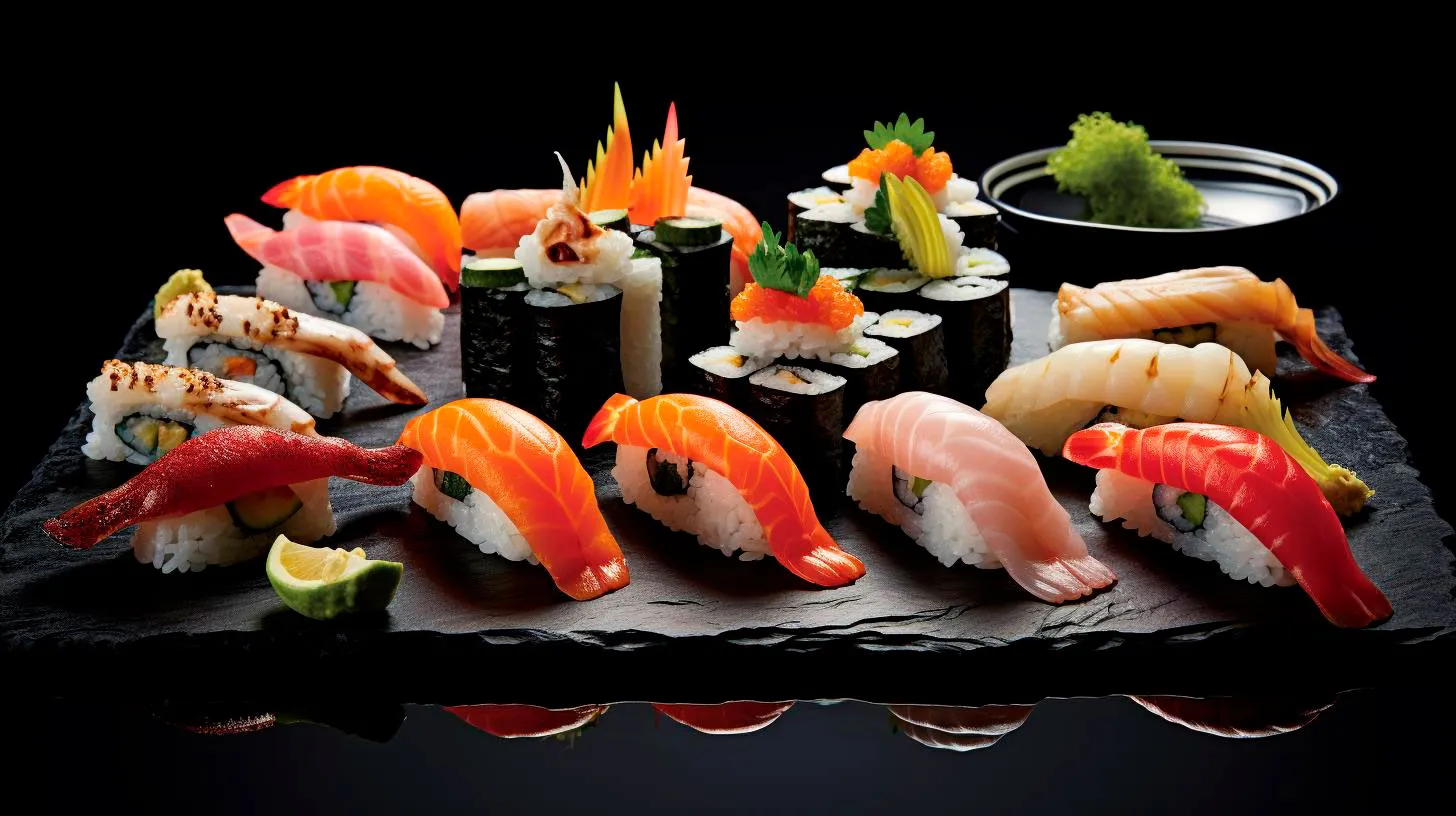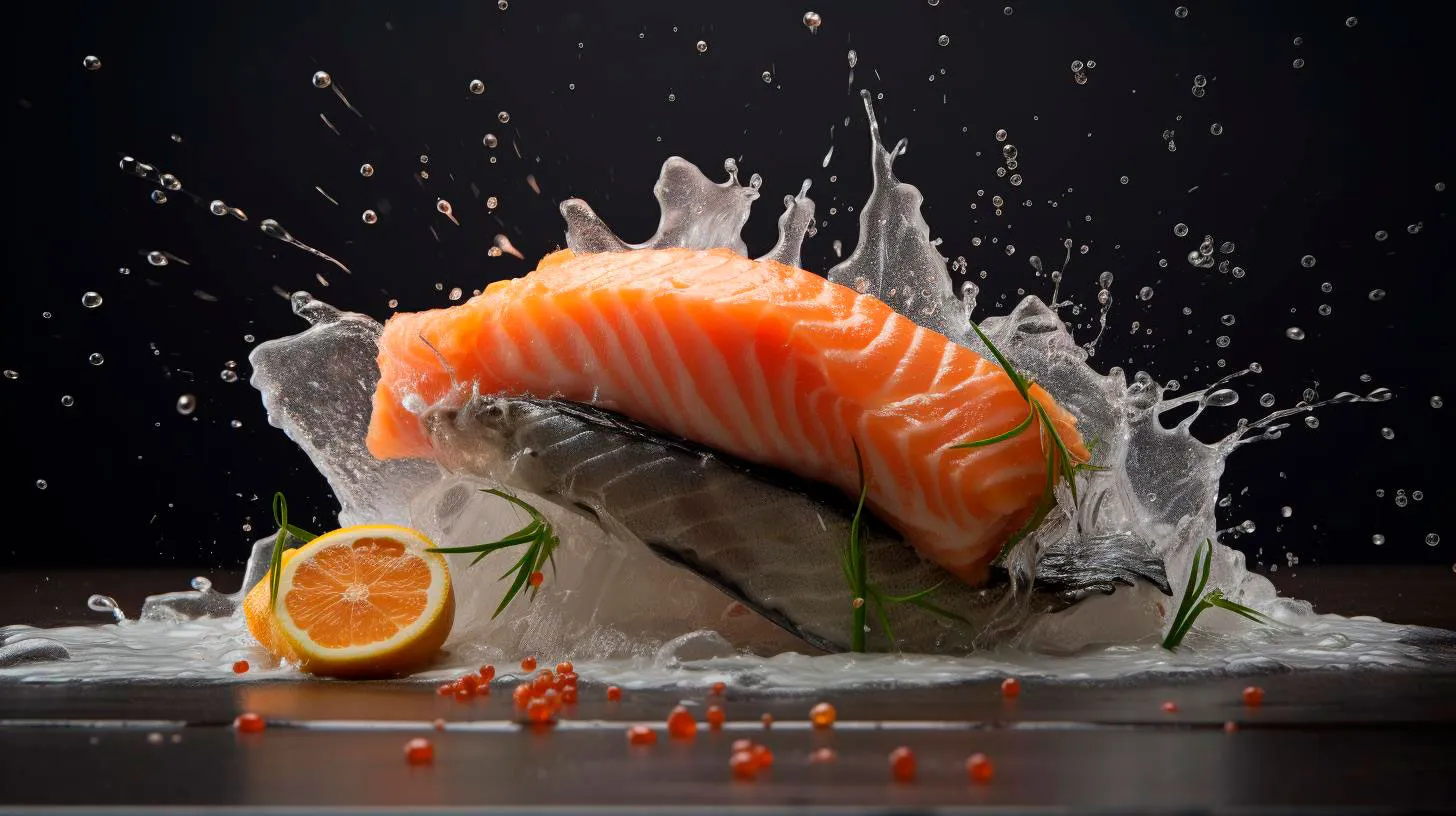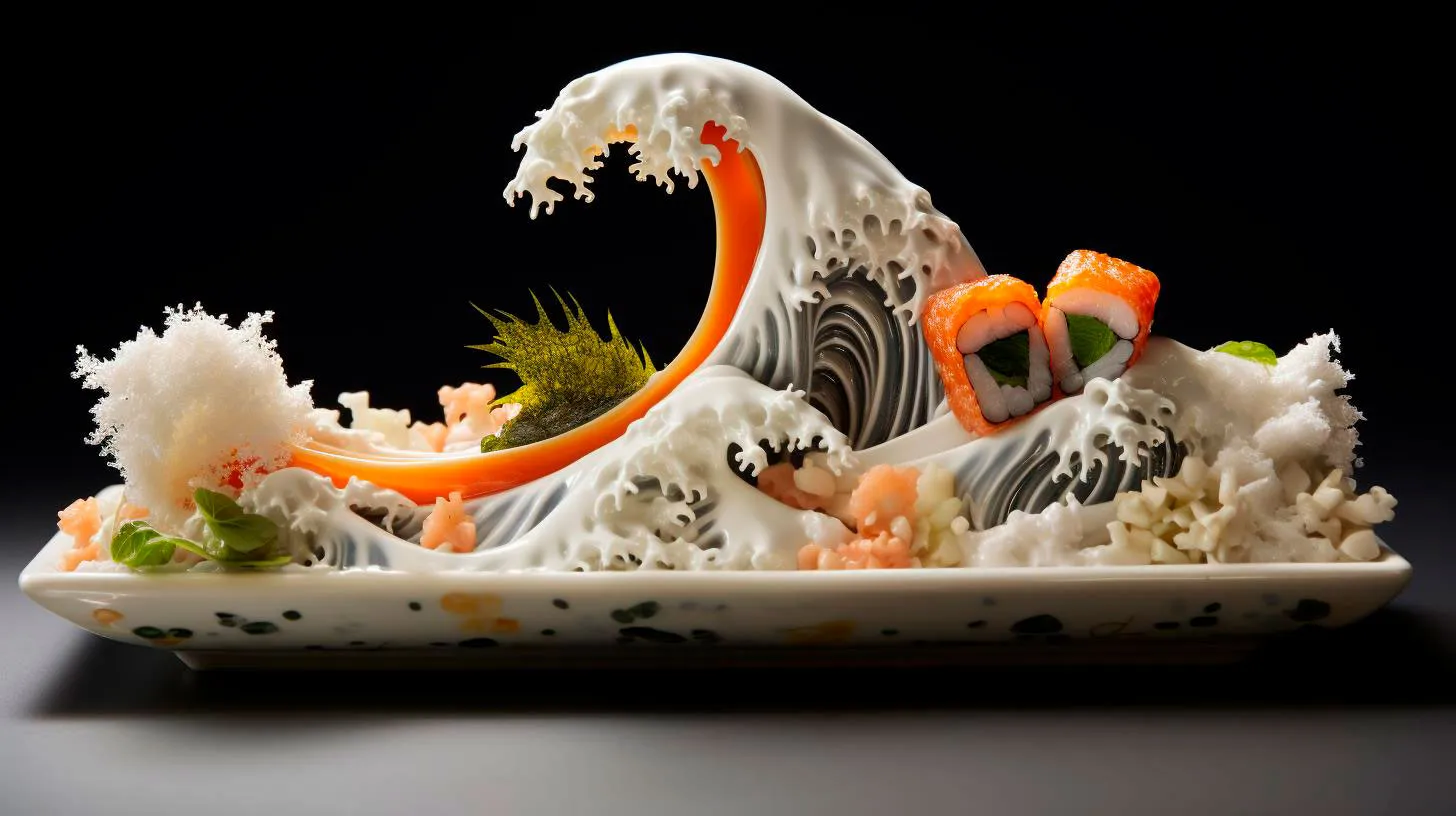The Art of Evolution: How Modern Sushi Chefs Are Revolutionizing Culinary Norms
This article dives into the art of evolution within the sushi world, exploring the techniques, trends, and mind-blowing creations that are revolutionizing culinary norms.
A Fusion of Tradition and Creativity
While sushi’s origins can be traced back to ancient Japan, modern sushi chefs have embraced the concept of fusion, marrying traditional techniques with contemporary flavors and ingredients. This unique combination has elevated sushi to new heights, enticing both purists and adventurous food enthusiasts alike.
- Creative Ingredient Pairings: Today’s sushi chefs fearlessly experiment with unusual flavor profiles, combining unexpected ingredients to create delightful taste experiences. From pairing uni (sea urchin) with foie gras to incorporating truffle oil into a traditional roll, these innovative combinations challenge our preconceived notions of sushi.
- Artistry on the Plate: Sushi has always been visually appealing, but modern chefs have taken it to the next level. Meticulously crafted and arranged, sushi has become a work of art on the plate. From intricate maki rolls that resemble vibrant flowers to nigiri that replicate famous landmarks, the presentation of sushi has become a feast for the eyes as much as the palate.
- Embracing Local Ingredients: Sushi has transcended borders and embraced local ingredients from around the world. Chefs now incorporate regional produce, seafood, and spices into their creations, adding a unique twist to traditional sushi. From avocado-filled California rolls to spicy tuna creations, regional adaptations have become a global sensation.
Advancing Techniques in Sushi Making
Modern sushi chefs are constantly pushing the boundaries of their craft by adopting innovative techniques and tools. These advancements not only enhance the flavors and textures but also contribute to the overall experience of enjoying sushi.
- Sous Vide Precision: The sous vide cooking method has made its way into the sushi world, allowing chefs to achieve precise control over temperatures and cooking times. This technique ensures that the seafood is cooked to perfection, resulting in tender, buttery textures that melt in your mouth.
- Nitro-Freezing: To preserve the freshness and quality of the ingredients, sushi chefs have embraced the technique of nitro-freezing. By dipping selected fish into extremely low-temperature liquid nitrogen, chefs can maintain the natural flavors and prevent the formation of ice crystals, resulting in a more vibrant and flavorful sushi experience.
- Smoking and Charring: Adding a smoky touch has become a new trend in the sushi world. Chefs use delicate smoking techniques and charring methods to infuse sushi rolls and nigiri with an enticing aroma and a hint of charred flavor. This technique adds depth and complexity to the overall taste profile.
The Future of Sushi
As sushi continues to evolve, there are some exciting trends and developments on the horizon. These forward-thinking creations are set to redefine the culinary landscape, enticing food enthusiasts with their innovation and ingenuity.
- Plant-based Sushi: With the rise of veganism and the growing concern for sustainability, sushi chefs are exploring plant-based ingredients to create delicious alternatives. By utilizing creative combinations of vegetables, seaweed, and even fruits, they are crafting sushi rolls that are not only visually stunning but also cater to a wider range of dietary preferences.
- Sushi Robots: To meet the increasing demand and maintain consistency, sushi robots are being introduced in some sushi restaurants. These automated machines can produce perfectly shaped sushi rolls at a rapid pace, ensuring efficiency without compromising quality. While traditional handcrafted sushi will always hold a special place, sushi robots present an interesting technological advancement in the industry.
In conclusion, the art of evolution in modern sushi is transforming culinary norms and captivating food lovers worldwide. By seamlessly blending tradition with creativity, incorporating unique ingredients, and adopting advanced techniques, sushi chefs continue to push the boundaries of this beloved cuisine. As sushi adapts to new tastes, trends, and technology, the future holds infinite possibilities for the “art on a plate” that is sushi.
Key Takeaways:
- Modern sushi chefs combine tradition with innovation, infusing unique flavors and ingredients to create memorable dining experiences.
- Sushi presentations have become works of art, with chefs meticulously arranging each piece to enhance its visual appeal.
- Advancements in cooking techniques such as sous vide and nitro-freezing contribute to the tenderness and freshness of sushi.
- The future of sushi holds promises of plant-based alternatives and the integration of technology through sushi robots.
Breaking Boundaries: Innovative Techniques and Ingredients in Contemporary Sushi
In this article, we will explore some of the most exciting developments in contemporary sushi, from unique cooking methods to unexpected ingredient combinations.
Technique: Aburi Sushi
One revolutionary technique that has taken the sushi world by storm is aburi sushi. Aburi, meaning “flame-seared” in Japanese, involves torching the surface of the fish briefly, resulting in a delectable smoky flavor and a slightly charred texture. This method adds a delightful twist to traditional sushi, enhancing the flavors and creating a visually stunning dish.
Key Takeaway: Aburi sushi offers a unique taste experience with its smoky flavor and visually appealing presentation.
Ingredient: Fusion Fillings
Gone are the days of sticking solely to traditional ingredients in sushi. Chefs are constantly experimenting with fusion fillings, combining flavors from different cuisines to create innovative and unexpected combinations. From Korean BBQ beef to Mexican-inspired spicy tuna, these inventive fillings add a burst of flavor and excitement to each bite.
Key Takeaway: Fusion fillings allow for endless possibilities, creating sushi that continually surprises and delights the taste buds.
Technique: Vegetable Sushi
While sushi is traditionally associated with seafood, contemporary sushi has seen a rise in the popularity of vegetable sushi. Chefs are embracing the diverse flavors and textures of vegetables to create stunning, plant-based sushi rolls. From crispy tempura asparagus to tangy pickled daikon, these vegetable options provide a refreshing and healthier alternative.
Key Takeaway: Vegetable sushi caters to the ever-growing demand for plant-based options, offering a healthier and equally delicious experience.
Ingredient: Exotic Seafood
Sushi enthusiasts are now being introduced to a whole new world of flavors with the introduction of exotic seafood into sushi recipes. Some examples include uni (sea urchin), mirugai (giant clam), and awabi (abalone). These unique ingredients not only add new dimensions of taste but also showcase the diversity and richness of the world’s oceans.
Key Takeaway: Incorporating exotic seafood into sushi offers an adventurous dining experience, celebrating the abundance of marine life around the globe.
Technique: Liquid Nitrogen Freezing
In the realm of sushi, presentation is key. Chefs are taking their creativity to new heights by using liquid nitrogen to freeze various components of their dishes. By flash-freezing items like sauces or fruits, chefs are able to create stunning visual effects, such as smoky vapors or shattering toppings, elevating the overall dining experience.
Key Takeaway: Liquid nitrogen freezing adds an element of theater to sushi, captivating diners with its visually captivating effects.
Ingredient: Sustainable Seafood
As sustainability becomes an increasingly important issue, sushi chefs are taking strides to ensure their ingredients are responsibly sourced. Many sushi restaurants are now working closely with suppliers who are committed to sustainable fishing practices, allowing diners to enjoy their favorite sushi guilt-free. This commitment not only protects the environment but also preserves the availability of these ingredients for future generations.
Key Takeaway: Choosing sushi made with sustainable seafood highlights the importance of responsible sourcing and helps sustain the world’s delicate marine ecosystems.
Conclusion
Contemporary sushi is breaking boundaries and challenging traditional notions of this beloved cuisine. Chefs are constantly pushing the envelope, utilizing innovative techniques and ingredients to create a sushi experience that is both visually stunning and full of unexpected flavors. By embracing techniques like aburi sushi and liquid nitrogen freezing, as well as incorporating fusion fillings and exotic seafood, sushi chefs are revolutionizing the way we perceive and enjoy sushi. So, the next time you sit down to savor a plate of sushi, prepare yourself for an adventure of flavors and textures that will undoubtedly leave a lasting impression.
Mastering Tradition: Honoring the Legacy of Sushi while Pushing the Culinary Envelope
In this article, we delve into the legacy of sushi, exploring its traditional roots, the contemporary twists that have emerged, and how chefs are pushing the boundaries to create a new sushi experience.
The Rich Tapestry of Traditional Sushi
Traditional sushi-making is an art form that requires precision, skill, and reverence for ingredients. The centuries-old techniques employed by master sushi chefs are still highly regarded today, ensuring that the legacy of sushi lives on. Key features of traditional sushi preparation include:
- High-quality ingredients: Traditional sushi relies on the freshness and quality of its ingredients, particularly the fish. Chefs carefully select fish that meets the highest standards, resulting in a melt-in-your-mouth experience.
- Handcrafted rice: The sushi rice is a crucial element, made by seasoned hands that have perfected the art of balancing flavors and achieving the perfect texture.
- Knife skills: To achieve the delicate precision required for sushi, chefs master the art of knife skills, ensuring each piece is cut with precision and elegance.
- Minimalist presentation: Traditional sushi is often served in a simple and elegant manner, allowing the flavors and textures of the ingredients to take center stage.

Contemporary Twists on Tradition
With sushi gaining global popularity, chefs have begun to incorporate their own innovative touches while still paying homage to the traditional techniques. These contemporary twists have elevated the sushi experience, attracting both purists and adventurous diners. Some notable advancements in sushi include:
- Fusion sushi: Chefs have combined traditional sushi with other cuisines, creating tantalizing flavor combinations such as sushi burritos or sushi tacos.
- Vegetarian and vegan options: To cater to diverse dietary preferences, chefs have introduced a variety of plant-based sushi options, using ingredients like tofu, avocado, and seasonal vegetables.
- Creative fillings: While fish remains a staple of sushi, chefs have embraced a wealth of new ingredients and fillings, including lobster, truffles, and even fruits like mango.
- Sushi rolls: Chefs have perfected the art of sushi rolls, providing a visually stunning presentation with intricate arrangements and artistic designs.

Pushing the Boundaries of Sushi
The world of sushi continues to evolve, with innovative chefs pushing the boundaries and challenging traditional norms. These avant-garde approaches redefine what sushi can be, introducing novel techniques and daring flavor combinations. Key takeaways from the cutting-edge evolution of sushi include:
- Deconstruction and reconstruction: Some chefs deconstruct classic sushi dishes and reconstruct them in creative ways, pushing the boundaries of presentation and taste.
- Molecular gastronomy: With the advent of molecular gastronomy, chefs experiment with scientific techniques to transform the textures and flavors of sushi.
- Unique plating: Presentation becomes a work of art as chefs explore unconventional plating styles, using elements like edible flowers, foams, and artistic garnishes to wow diners.

As the culinary world continues to evolve, sushi remains a testament to the harmony of tradition and innovation. Honoring the legacy of Japanese sushi while pushing the culinary envelope allows chefs to captivate our taste buds and provide unforgettable dining experiences. Whether you prefer the elegance of traditional sushi or the excitement of avant-garde creations, there’s a sushi journey waiting for everyone.
Beyond Tradition: Exploring the Fusion of Sushi with Global Cuisines
By incorporating ingredients and techniques from other culinary traditions, sushi has been given a modern twist, resulting in unique and exciting flavor combinations. In this article, we will delve into the world of fusion sushi, its advantages, key takeaways, and why this culinary trend has gained so much traction.
The Evolution of Fusion Sushi
Sushi has a rich history rooted in traditional Japanese cuisine. Its origins can be traced back to rice preservation techniques used in Southeast Asia. Over time, sushi evolved into an art form, with chefs showcasing their skills in precision and presentation. However, with globalization and the desire for culinary experimentation, sushi has transcended its traditional boundaries and embraced influences from various cuisines.
The fusion of sushi with global cuisines has resulted in a delightful array of flavors and textures. By combining ingredients like Mexican jalapenos, Indian curry, or Italian pesto with classic sushi elements, chefs have created innovative and unexpected taste experiences. This fusion approach bridges the gap between different culinary traditions, appealing to a wide range of palates and preferences.
The Advantages of Fusion Sushi
-
Expanding Flavor Profiles:
Fusion sushi enables chefs to create unique flavor combinations that cater to diverse palates. By blending traditional sushi techniques with global ingredients, a multitude of tastes and textures can be achieved.
-
Increased Variety:
The fusion of sushi with global cuisines offers a wider range of options for diners. It introduces exciting alternatives to the classic sushi menu, allowing individuals to explore new culinary experiences.
-
Enhanced Creativity:
Fusion sushi encourages chefs to think outside the box and experiment with unconventional ingredient pairings. This creativity brings a fresh and dynamic element to sushi, attracting adventurous eaters seeking novel taste sensations.
The Key Takeaways
Fusion sushi represents the harmonious marriage of traditional Japanese cuisine and global culinary influences. By embracing this trend, both chefs and diners have the opportunity to explore unique flavor combinations and expand their gastronomic horizons. Here are the key takeaways:
- Sushi has evolved beyond its traditional boundaries and embraced flavors from different corners of the world.
- Fusion sushi introduces exciting alternatives and expanded variety to the classic sushi menu.
- The fusion approach fosters creativity, allowing chefs to experiment with unexpected ingredient pairings and techniques.
- This trend appeals to a broad audience, catering to diverse palates and preferences.
As fusion sushi continues to gain popularity, it is evident that this culinary trend has become more than just a passing fad. Its ability to bridge cultural gaps and create unique taste experiences has made it a mainstay in the global culinary scene. So, the next time you crave sushi, venture beyond tradition and embark on a thrilling gastronomic adventure with fusion sushi!



